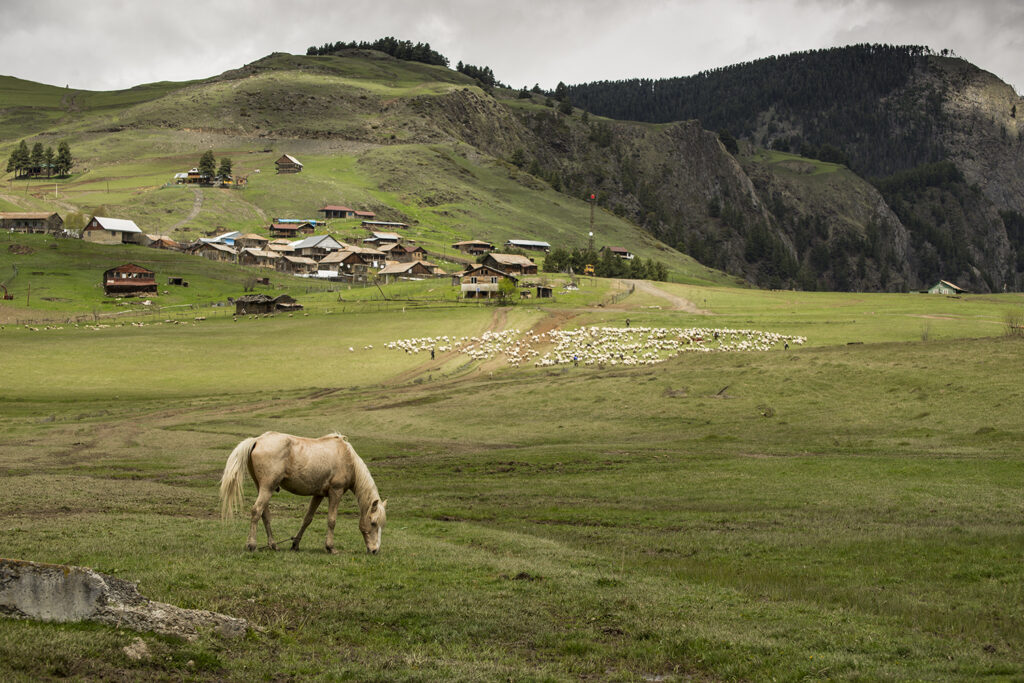AKHMETA IN
FULL SPLENDOR
Nestled at the meeting point of the Alazani, Ilto, and Orvili rivers, stands the proud little town of Akhmeta, immersed in grand history. It has long been a focal point, and the administrative center of a unique region, once known as the foothills. Today this area represents the Akhmeta Municipality and is stretched across the eastern reaches of Georgia in the Kakheti region. Framed by the expansive Alazani plains and the majestic ridges of the Caucasus, this historic land is among Georgia’s most authentic and diverse regions. With centuries of accumulated knowledge and legacy, it is now poised to reveal its treasures to the world and emerge in full splendor.

A sacred place of blessing
Akhmeta’s landscape is a striking palette of geomorphological contrasts, colors, and natural textures. Its orographic spectrum begins in the south with the Alazani plains and rises to the snow- capped peaks of the Tusheti -Khevsureti and Kakheti sections of the Caucasus. The region’s ridges and valleys—whether it’s the Pirikita, Atsunta, or Gombori ranges, the Pankisi Gorge, or the Tusheti basin—add a vibrant array of tones to Akhmeta’s geographical tapestry. From its highest peaks to its lowest plains, the entire region is veined with swift mountain rivers, shimmering lakes, and underground springs. Yet, Akhmeta is indeed the land of three Alazanis. From three different glaciers on three separate ridges—Pirikiti, Atsunta, and Borbalo—three rivers are born around 3,000 meters above sea level: Pirikiti Alazani, Tusheti’s Alazani, and Alazani. They are fed by snow, rain, and underground springs, setting off on their journey toward the plains. Along this flow, a unique harmony of untouched valleys, terrains, climate, flora, and fauna comes into being, crystallizing into three strict nature reserves: Batsara, Babaneuri, and Tusheti. Thus, Akhmeta is unique in Georgia, being the first administrative area to house three distinct types of reserves together. Spanning 2,207.6 square kilometers, Akhmeta’s land with its reserves, glaciers, plains, alpine meadows, rivers, and unparalleled flora and fauna, is a living, breathing organism with its own role and story to tell in the grand narrative of the world.
Humans on Primeval Land
Traces of human life on Akhmeta’s lands stretch back to the Stone Age. Archaeological discoveries unearthed in the region – especially the renowned early and middle Bronze Age settlement and burial ground of ‘Ilto’ – stand as silent witnesses to this ancient heritage. The abundance of artifacts in the Akhmeta area tells a profound story: an unbroken cycle of human existence has continued on these lands from the Stone Age to the present day. One of the key reasons for this continuity lies in the secret of Akhmeta’s ancient roads. For millennia, these valleys and lands were crisscrossed by routes, pathways – lifelines, that connected regions, villages, countries and even nations. By the 5th to 8th centuries CE, the territory of modern-day Akhmeta was governed by two powerful principalities: PankisiandKvetera. These principalities controlled the major trade and caravan routes, as well as key passes of the northeastern Caucasus. Due to these pivotal roads and its strategic geopolitical position, Akhmeta has always been poised to play an active role in the economic, political, and cultural rhythm of the Caucasus, feeling the pulse of the region with each passing era.
Polyphony or Symphony of Diversity
Shaped by millennia of historical events and cultural processes, Akhmeta stands today, in the 21st century, as one of Georgia’s most authentic and ethnically diverse regions. Within the administrative boundaries of Akhmeta lie the distinct landscapes and deep-rooted culture of Kakheti, along with Tusheti’s unique architecture, timeless traditions, and towering peaks. Also, among its treasures lies a hidden gem waiting to be discovered: Pankisi Valley, a 34-kilometer stretch steeped in history. From the 1830s to 1850s, Kists from Maista (Historic Region in Chechnya) began settling down in Pankisi Gorge, blending their ancestral lifestyle with local traditions. This fusion gave rise to a unique community that has become an inseparable part of Akhmeta’s identity. Today, Akhmeta’s densely populated land is home to not only indigenous Kakheti residents but also compact communities of Ossetians, Kists, Chechens, and ecomigrants from other Georgian mountain regions, such as Pshavi and Khevsureti. The contrasts defining the region—its ethnic diversity, differing lifestyles of highland and lowland communities, agriculture, and traditions —have intertwined over the centuries, creating a one-of-a-kind, human-made culture. Timeless messages—etched in petroglyphs or exclusive tower-wineries, with flourishing viticulture, incomparable azure-glazed tiles of Kvetera Church, the majestic Alaverdi Monastery rising above the Alazani plains, or the vibrant Tushetian carpets interwoven with the essence of life—all vividly reflect Georgia’s unbroken history through Akhmeta’s lens.